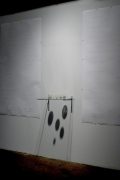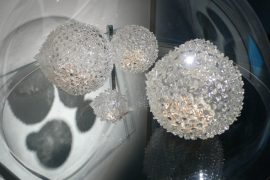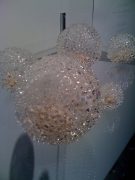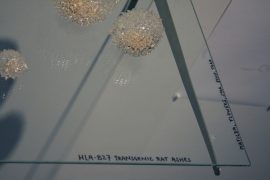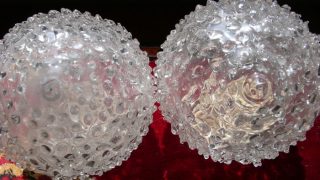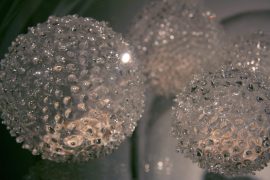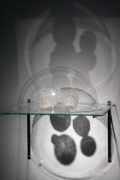
Burial Globes: Rat Models
2009
This is a memorial to transgenic rats. Five glass globes house the cremated ashes of the transgenic rats from the project Embracing Animal. Alongside these are banners listing all transgenic rats’ model codes, disease types and the scientific team and year created.
Naming is an act of personalizing, individuating, and commemorating. Five glass globes (in the shape of white blood cells) hold the ashes of the five HLA-B27 transgenic rats High worked with in the past, each one named and remembered: Echo, Flowers, Tara, Matilda, Star. The faint, almost invisible script on the wall lists a history of the various types of transgenic lab rat models developed from 1990-2008 (thanks to the scientists who generated these tables: Ignacio Anegon, M.D. and Séverine Ménoret, INSERM U643, Nantes, France).
There are over 80 million lab rodents used every year in scientific research in this country alone. These pieces are symbolic gestures to ritualize their work with humans and bring us closer together – as we are all animals and sentient beings working together.
Credits: Echo, Flowers, Tara, Matilda and Star burial globes; glass blower Bill Jones
Dimensions: (5) glass globes with HLA B27 transgenic rat ashes on glass shelf 24”w x12”d x .25” thick, various sizes from 2” to 5”
Rat Models banners is a list of selected transgenic lab rat models; designer Diane Bertolo; printing Seana Biondillio. Dimensions: (4) 20” x 84” photographs
Burial Globes: Rat Models
2009

Naming is an act of personalizing, individuating, and commemorating. Five glass globes (in the shape of white blood cells) hold the ashes of the five HLA-B27 transgenic rats High worked with in the past, each one named and remembered: Echo, Flowers, Tara, Matilda, Star. The faint, almost invisible script on the wall lists a history of the various types of transgenic lab rat models developed from 1990-2008 (thanks to the scientists who generated these tables: Ignacio Anegon, M.D. and Séverine Ménoret, INSERM U643, Nantes, France).
There are over 80 million lab rodents used every year in scientific research in this country alone. These pieces are symbolic gestures to ritualize their work with humans and bring us closer together – as we are all animals and sentient beings working together.
Credits: Echo, Flowers, Tara, Matilda and Star burial globes; glass blower Bill Jones
Dimensions: (5) glass globes with HLA B27 transgenic rat ashes on glass shelf 24”w x12”d x .25” thick, various sizes from 2” to 5”
Rat Models banners is a list of selected transgenic lab rat models; designer Diane Bertolo; printing Seana Biondillio. Dimensions: (4) 20” x 84” photographs











